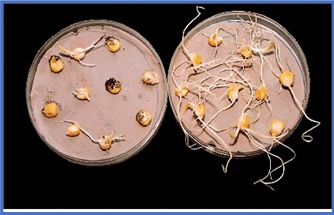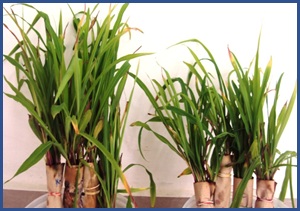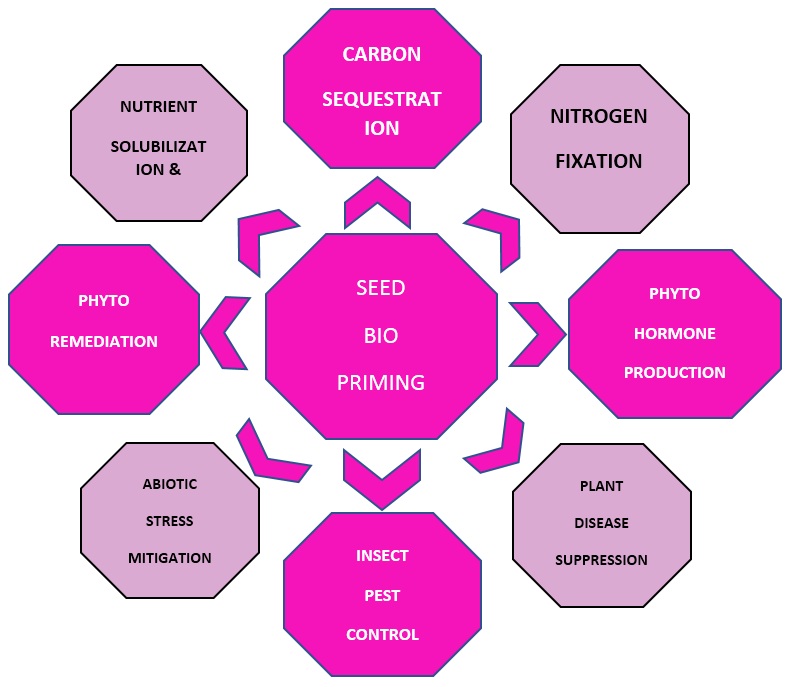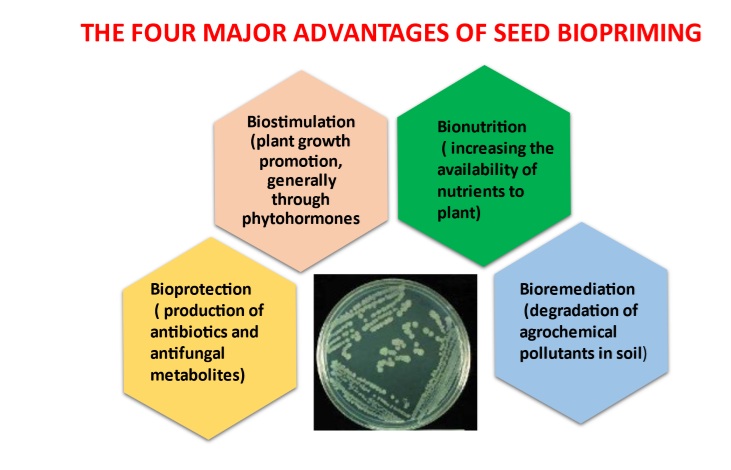BIOLOGICAL SEED PRIMING: ESSENTIAL TO ENHANCE CROP PRODUCTIVITY
Dr. KRK REDDY
Director, Prof.Bir Bahadur Centre for Crop Microbiome and Nano Research
Sri BioAesthetics Pvt.Ltd, Hyderabad, India
Introduction:
Plants and microbes are inseparable. Microbes live in every part of the plant. They live on the surface of the plants as epiphytes and inside as endophytes, they even do not leave flowers, fruits, and seeds. Microbes have great influence on plants and their association is more of beneficial to the plants. Seed biopriming microbes assist in nutritional and defense-related aspect and influence various genetic events , biochemical pathways, and metabolite accumulation.
Seed Biopriming or Seed Invigoration is coating/treating the seeds with beneficial micro-organisms and biocontrol agents which now became globally accepted procedure in sustainable agricultural practices. Biopriming microbes increases availability of nutrients to the plants, induces systemic tolerance towards abiotic and biotic disturbances under varied ecological situations through various structural, physiological, and biochemical modifications within the plant. The advantages of seed biopriming is not limited to enhancing seed viability and vigor but includes numerous other beneficial effects, witnessed when different microbes are used to treat the seeds, stand alone or in combination (Fig.1). Popularly these groups of organisms are called Plant Growth Promoting Microbes (PGPM), comprising of both bacteria and fungi. The PGPM’s when introduced through seeds, acts in many ways to support germinating seeds, seedlings and plants facilitating nitrogen fixation, nutrient mobilization, nutrient acquisition through solubilization, phytohormone production. Apart from PGPMs, some of the antagonistic, biocontrol agents such a s Trichoderma sps. and fluorescent Pseudomonads proved promising to control seed and soil borne phytopathogens through disease suppressing metabolite production and abiotic stress mitigating components. Unlike chemicals, biopriming of seeds is the safest and environmentally sound practice along with its cost effectiveness. The major benefits of biopriming over chemical applications is that microbes multiply enough to form a biofilm on the surface of the roots and protect the plants from various soil-borne plant pathogens all through the growing stages. This apart, microbial metabolite triggers the production of elicitor molecules to activate systemic resistance in plants that can protect them from foliar pathogens during the maturation stages of growth and development.
Various biopriming methods activates defense responses cellularly, molecularly, and biochemically. This helps plants to withstand a wide range of plant diseases and environmental stresses. Biopriming process starts with Isolation, characterization, and selection of PGPM strains which involves cutting edge technologies and considerable time for screening candidate microbes, functional assessment through OMICS, formulation development, in vitro and in vivo bio-efficacy studies.
Microbes widely used in seed biopriming:
The most popular PGPM’s used in seed biopriming are Azospirillum, Azatobacter, Rhizobium, Agrobacterium,Burkholderia,Acinetobacter, Enterobacter, Klebsiella, Pantoea, Pseudomonas, Serratia, Bacillus, Frankia, Gliocladium sp.
The biocontrol agents are Trichoderma viridae, Trichoderma harzianum, Trichoderma hamatum, Clonostachys rosea, Gliocladium roseum, Chaetomium bostrycoides.
Major advantages and Mode of actions of Seed biopriming:
The various actions of PGPM’s and Bio Control Agents are (fig.4) very well documented with experimental proof and some products are globally available for seed priming.
A. Nutrient uptake, Growth and development
Most of the plant growth promoting microorganisms improves nutrient uptake from the soils, thereby reducing the need of external application of fertilizers and reducing the deposition of nitrates and phosphates in the soils. The cutback on the use of chemical fertilizers would reduce the ill effects of water contamination from fertilizer erosion and lead to reduction of input cost to the farmers. Bacteria are the most plentiful of soil microbes and play fundamental role in nutrient cycling for maintaining soil fertility. There are two kinds of beneficial microbes in the rhizosphere: (a) microbes having intimate relationship with the plants as a symbiont through specialized structures and (b) free-living microbes present in the close surrounding of plant root system.
In many of the studies it is proved that seed biopriming revealed that microbes associated with the seeds enhanced crop productivity through complex plant-microbe interactions. The key functions include P and K remobilization, N2 fixation, iron sequestration, microbial phytohormones, functional enzymes, vitamins, metabolites and beneficial organic acids secretion, nutrient uptake facilitation via hyphae, seed emergence promotion, active metabolites production, vigorous seedlings establishment.
B. Abiotic stress mitigation
Globally, most of the crop plants face several abiotic stresses like temperature, drought, salinity that can affect seed quality and the yield; these abiotic stresses may decrease seed germination, seedling vigor and crop uniformity leading to lower yields. To optimize the seed production technologies, integration of microbial inoculants is gaining importance these days, which is highly efficient and cost-effective. Development and integration of trait-specific microbial inoculants is gaining global importance in mitigating abiotic and biotic stresses through seed bio-priming.
A variety of mechanisms have been projected for microbial stimulated abiotic stress tolerance in plants. Stress tolerance conferred to plants symbiotically, involves two mechanisms: (1) activation of host’s immune response system on exposure to stress conditions (2) in situ production of antistress biochemical compounds like gibberlic acid, cytokinins, IAA and Abscisic acid by endophytes.
C.Biotic stress intervention
Bio-priming is an efficient tool for use of biocontrol agents for inducing resistance in plants. Wide range of fungal bioagents help in mitigating biotic and biotic stresses in plants through various kinds of interactionsTrichoderma harzianum is one of the most widely used fungi for bio-priming as it shows antagonism against a wide range of plant pathogens.
Symbiotic fungi, vesicular- arbuscular mycorrhiza (VAM), have shown significant results in combating abiotic stresses especially drought conditions.
Biotic stress intervention is achieved by mechanisms like destructive mycoparasitism, forming a physical barrier, iron chelating by production of siderophores, producing cell wall degrading enzymes, and antagonistic substances like cyanides and antibiotics.
D.Bioremediation:
Pesticides contamination of the soil and water is a real hazard to human beings and other life forms. Certain category of microbes when used for seed treatment in combination of PGPMs, proved to be beneficial in phytoremediation by changing the rhizosphere environment, increasing biomass production and bioavailability of nutrients. Microorganisms degrade the harmful pesticide residues in soil by several biochemical mechanisms like release of various enzymes which carry out oxidative transformations, C-P cleavage reactions etc.
Bacillus, Pseudomonas, Flavobacterium, Moraxalla, Acinetobacter, Arthrobacter, Paracoccus, Aerobacter, Alkaligens, Burkholderia and Sphingomonas are the major bacterial genera which have bioremidiation capabilities.
Fungi with pesticide degradation potential include: Fusarium, Aspergilus niger, Penicillium, Lentinulaedodes, Lecanicillium, Oxysporum and Streptomycetes.
Seed biopriming in seed production:
There are several seed coating techniques widely used in seed industry and seed production largely limited to chemicals and polymers. Seed biopriming has tremendous advantage to the seed production industry. Utilization of seed microbiomes and other promising bioagents have come into practice to improve seed vigour and carry these seed associated microbes to next generations like various genetic traits. Modifying seed and soil interface with addition of these beneficial microbes is as an important tool in quality seed production in many crops. Therefore, the seed production industry will be the first to benefit from seed biopriming tools and techniques.
Biological Seed Treatment business:
The agricultural microbials market was valued at USD 6.0 Billion in 2020, and is projected to reach USD 11.6 Billion by 2025, growing at a CAGR of 14.1%. The Global Inoculants Market is Estimated to Reach US$ 808 Million in 2019 and is Projected to Account for US$ 1,207 Million by 2025, Recording a CAGR of 6.9%. The market for seed treatment was valued at USD 6.8 billion in 2017; it is projected to reach 8.3 billion by 2027 grow at a CAGR of 10.8%. The global biological seed treatment market size was USD 830.3 million in 2018 and is expected to grow at an estimated CAGR of 11.6 % from 2019 to 2025.
Conclusion:
The ever-increasing seed, soil health and fertility problems and crop productivity is the major hurdle to achieve food security for the exponentially increasing world population which is expected to reach 9.3 billion by 2050. Attaining food security for a this vastly growing global population is a major challenge. In a recently conducted study it was reported that improving soil health alone can increase productivity by 10–15% and in combination with other with effective agricultural practices the productivity can be increased up to 50–60%.
Seed is the fundamental unit of any crop. It is important that the seed is not infested with pathogens, otherwise the plant growing from it will be diseased and unhealthy and yield will be low. It is important to protect the seed health and biopriming of the seed is now becoming an essential practice to enhance crop productivity.
References:
Seed biopriming with plant growth promoting rhizobacteria: a review: Ahmad Mahmood 1, Oğuz Can Turgay 2, Muhammad Farooq 3, Rifat Hayat 4FEMS Microbiol Ecol 2016
Seed coating with beneficial microorganisms for precision agriculture.
Ma Y. Biotechnol Adv. 2019 Nov 15;37(7):107423. doi: 10.1016/j.biotechadv.2019.107423. Epub 2019
Seed Biopriming with Potential Microbial Inoculants as Sustainable Options for Stress Management in Crops: Ratna Prabha, Dhananjaya Pratap Singh, Sudheer K. Yadav Microbial Interventions in Agriculture and Environment pp 211-224, 2019
Seed Biopriming with Microbial Inoculant Triggers Local and Systemic Defense Responses against Rhizoctonia solani Causing Banded Leaf and Sheath Blight in Maize (Zea mays L.): Shailendra Singh 1,2,† , Udai B. Singh 1,† , Deepti Malviya 1 , Surinder Paul 1,‡ , Pramod Kumar Sahu 1,‡ , Mala Trivedi 2,*, Diby Paul 3 and Anil Kumar Saxena, Int. J. Environ. Res. Public Health 2020, 17, 1396
Seed biopriming with P- and K-solubilizing Enterobacter hormaechei sp. improves the early vegetative growth and the P and K uptake of okra (Abelmoschus esculentus) seedling: Muhamad Aidilfitri Mohamad Roslan ,Nurzulaikha Nadiah Zulkifli ,Zulfazli M. Sobri ,Ali Tan Kee Zuan ,Sim Choon Cheak , Nor Aini Abdul Rahman , PLOS ONE, doi: https://doi.org/10.1101/2020.04.24.059303

Fig:2 Maize seeds treated (right) with consortium of microbes showing improved percentage of germination, vigour and tolerance to infections when compared to untreated (left)

Fig:2 Maize seedlings treated (left) with consortia of microbes in paper towel showing improved growth over untreated (rig

